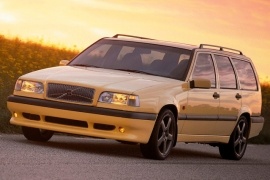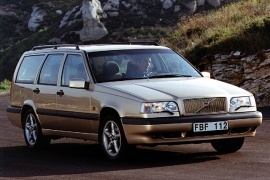VOLVO 850 Estate Models/Series Timeline, Specifications & Photos
First production year: 1993
Engines: Gasoline, Diesel
Body style: Wagon (station wagon, estate, combi, touring)
Volvo had a long tradition in building station wagons, but the 850 R was different than anything else the Swedish carmaker ever did.
When Volvo produced the R-version, it entered into the British Touring Car Championship with the station-wagon. It was the only vehicle with that body shape, and the organizer had to change the rules, so the Swedish brand had to switch for the sedan version in 1995. Even though it didn't win any race with the 850R Estate, it made a very good impression, and the sales increased.
The new design language introduced by the 850 sedan in 1992 took everybody by surprise. The sloped hood, rounded edges, and curved windshield were just a few elements that made the 850 so special in Volvo's history. Its long roofline was similar to other station wagons produced by the Swedish carmaker, but the roof-spoiler at the top of the tailgate was different. It was more of a wing than just a lip.
Inside, due to the front-wheel-drive system, it wasn't that cramped anymore in the front. Since it was a special version, Volvo installed sport seats at the front and kept the same bench in the rear as on the rest of the station-wagon lineup, but used better materials. The dashboard was still in cubic style design, with a big center stack.
Under the hood, Volvo stuck a five-cylinder turbocharged engine that provided 240 hp. The standard transmission was a five-speed manual and power was sent to the front wheel. Unlike its less-powered siblings, the 850R Estate featured stiffer suspension and wider light-alloy wheels.
Volvo broke the rules of its older design trends when it introduced the 850 sedan in 1991 and continued improvement with the 1993 station-wagon version.
The 850 was a sure step toward the front-wheel-drive systems for Volvo. Even though it wasn't the first FWD car in the Swedish carmaker lineup, it showed its commitment to that trend and proved that it could do that all by itself. The 400 series was made together with some help from Renault, who was a front-wheel-drive specialist.
While the front of the car was carried over from the sedan version, the 850 Estate (or Sportswagon in the U.S.) was different from the B-pillar behind. Its flat and long roof was designed to provide a smooth airflow, while the tailgate was flat and vertical. The car proved to be very aerodynamically effective, and the carmaker used this body version in the BTCC (British Touring Car Championship). Volvo installed vertical taillights that flanked the wide liftgate at the back, making the vehicle easy to recognize in traffic and utterly different from its siblings.
Inside, Volvo improved again. It installed a 60/40 split-folding rear bench, not only the seatback. Thus, it could increase the trunk size from 793 liters (28 cu-ft) up to 1,585 liters (56 cu-ft). But that was not all. The front passenger's seat was folding, increasing the loading length from tail to dashboard to 2.78 m (109.4 in).
Depending on the market, the 850 Estate featured diesel or gasoline engines. Volvo installed them transversely at the front, thus resulting in a roomier interior.

